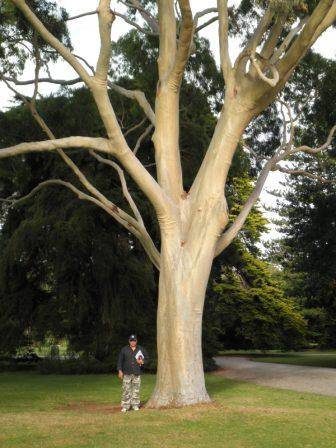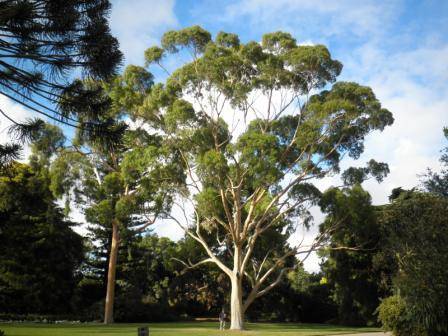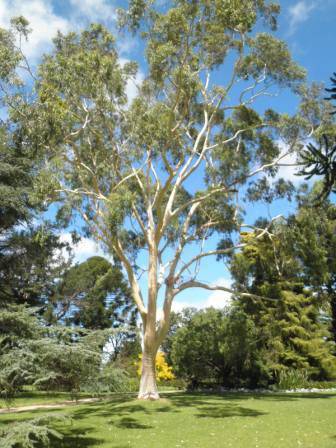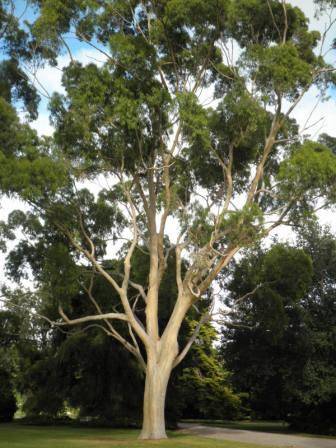| Back to search results » | Back to search page » |
|
Corymbia citriodora
Other NameLemon Scented Gum LocationWerribee Park Mansion, 320 K Road,, WERRIBEE VIC 3030 - Property No T12170
File NumberT12170LevelState |
|
Statement of Significance
What is significant?
Contribution to landscape of historic garden
Outstanding size
Aesthetic significance
Historical value
Outstanding example of species
These two Lemon-scented Gums (Corymbia citriodora), located along the Main Carriage Drive from the historic Gatehouse of Werribee Park Mansion, are relatively young at 52 years of age but exhibit the mature size and silhouette of specimens elsewhere that have taken up to 100 years to attain. Their mature silhouettes can truly be appreciated by their significant size and bright exfoliating bark texture. They were planted in 1960 in what is known as Citriodora Lawn as focal points when people drove up the new driveway entrance (Church Drive) from K Road to enter the Main Carriage Drive of Werribee Park (at the time Corpus Christi College). The Church was advised by the famous Melbourne garden designer, Edna Margaret Walling (1895 - 1973), in regards to this new drive entrance and suitable plantings.
The selection and planting of the three Lemon-scented Gums in this lawn area at the end of the Church Drive reflects the growing interest of Australian gardeners and landscape designers in native trees and plants. By the mid-1940s Edna Walling had developed a particular interest in native plants even though she had used them since the 1920s. These specimens embody a distinctive cultural shift in Melbourne society in regard to native flora. This is very significant as a compliment and contrast to the Chirnside era of the garden at Werribee Park in the nineteenth century. Even though the original garden design used large native trees like Ficus, Araucaria and Lagunaria there was a strong essence of trying to replicate the large estate gardens in Europe - creating an "ordered Eden" in harsh and intimidating Australian surrounds.
Outstanding size
Aesthetic significance
Historical value
Outstanding example of species
These two Lemon-scented Gums (Corymbia citriodora), located along the Main Carriage Drive from the historic Gatehouse of Werribee Park Mansion, are relatively young at 52 years of age but exhibit the mature size and silhouette of specimens elsewhere that have taken up to 100 years to attain. Their mature silhouettes can truly be appreciated by their significant size and bright exfoliating bark texture. They were planted in 1960 in what is known as Citriodora Lawn as focal points when people drove up the new driveway entrance (Church Drive) from K Road to enter the Main Carriage Drive of Werribee Park (at the time Corpus Christi College). The Church was advised by the famous Melbourne garden designer, Edna Margaret Walling (1895 - 1973), in regards to this new drive entrance and suitable plantings.
The selection and planting of the three Lemon-scented Gums in this lawn area at the end of the Church Drive reflects the growing interest of Australian gardeners and landscape designers in native trees and plants. By the mid-1940s Edna Walling had developed a particular interest in native plants even though she had used them since the 1920s. These specimens embody a distinctive cultural shift in Melbourne society in regard to native flora. This is very significant as a compliment and contrast to the Chirnside era of the garden at Werribee Park in the nineteenth century. Even though the original garden design used large native trees like Ficus, Araucaria and Lagunaria there was a strong essence of trying to replicate the large estate gardens in Europe - creating an "ordered Eden" in harsh and intimidating Australian surrounds.
Measurements: 12/02/2012
Spread (m): Southern specimen E-W 28; N-S 28.7
Spread (m): Northern specimen E-W 27.0; N-S 27.8
Girth (m): Southern specimen 3.45; Northern specimen 3.20
Height (m): Southern Specimen: 28; Northern specimen 28.6
Estimated Age (yrs): 52
Condition: Excellent
Measurements: 08/12/2022
Spread (m): Northern specimen E-W 29.0; N-S 29.0
Girth (m): Northern specimen 3.83
Height (m): Northern specimen 30.1
Estimated Age (yrs): 62
Condition: Excellent
Access: Unrestricted
Classified: 28/05/2012
Spread (m): Southern specimen E-W 28; N-S 28.7
Spread (m): Northern specimen E-W 27.0; N-S 27.8
Girth (m): Southern specimen 3.45; Northern specimen 3.20
Height (m): Southern Specimen: 28; Northern specimen 28.6
Estimated Age (yrs): 52
Condition: Excellent
Measurements: 08/12/2022
Spread (m): Northern specimen E-W 29.0; N-S 29.0
Girth (m): Northern specimen 3.83
Height (m): Northern specimen 30.1
Estimated Age (yrs): 62
Condition: Excellent
Access: Unrestricted
Classified: 28/05/2012
How is it significant?
Contribution to landscape of historic garden
Outstanding size
Aesthetic significance
Historical value
Outstanding example of species
These two Lemon-scented Gums (Corymbia citriodora), located along the Main Carriage Drive from the historic Gatehouse of Werribee Park Mansion, are relatively young at 52 years of age but exhibit the mature size and silhouette of specimens elsewhere that have taken up to 100 years to attain. Their mature silhouettes can truly be appreciated by their significant size and bright exfoliating bark texture. They were planted in 1960 in what is known as Citriodora Lawn as focal points when people drove up the new driveway entrance (Church Drive) from K Road to enter the Main Carriage Drive of Werribee Park (at the time Corpus Christi College). The Church was advised by the famous Melbourne garden designer, Edna Margaret Walling (1895 - 1973), in regards to this new drive entrance and suitable plantings.
The selection and planting of the three Lemon-scented Gums in this lawn area at the end of the Church Drive reflects the growing interest of Australian gardeners and landscape designers in native trees and plants. By the mid-1940s Edna Walling had developed a particular interest in native plants even though she had used them since the 1920s. These specimens embody a distinctive cultural shift in Melbourne society in regard to native flora. This is very significant as a compliment and contrast to the Chirnside era of the garden at Werribee Park in the nineteenth century. Even though the original garden design used large native trees like Ficus, Araucaria and Lagunaria there was a strong essence of trying to replicate the large estate gardens in Europe - creating an "ordered Eden" in harsh and intimidating Australian surrounds.
Outstanding size
Aesthetic significance
Historical value
Outstanding example of species
These two Lemon-scented Gums (Corymbia citriodora), located along the Main Carriage Drive from the historic Gatehouse of Werribee Park Mansion, are relatively young at 52 years of age but exhibit the mature size and silhouette of specimens elsewhere that have taken up to 100 years to attain. Their mature silhouettes can truly be appreciated by their significant size and bright exfoliating bark texture. They were planted in 1960 in what is known as Citriodora Lawn as focal points when people drove up the new driveway entrance (Church Drive) from K Road to enter the Main Carriage Drive of Werribee Park (at the time Corpus Christi College). The Church was advised by the famous Melbourne garden designer, Edna Margaret Walling (1895 - 1973), in regards to this new drive entrance and suitable plantings.
The selection and planting of the three Lemon-scented Gums in this lawn area at the end of the Church Drive reflects the growing interest of Australian gardeners and landscape designers in native trees and plants. By the mid-1940s Edna Walling had developed a particular interest in native plants even though she had used them since the 1920s. These specimens embody a distinctive cultural shift in Melbourne society in regard to native flora. This is very significant as a compliment and contrast to the Chirnside era of the garden at Werribee Park in the nineteenth century. Even though the original garden design used large native trees like Ficus, Araucaria and Lagunaria there was a strong essence of trying to replicate the large estate gardens in Europe - creating an "ordered Eden" in harsh and intimidating Australian surrounds.
Measurements: 12/02/2012
Spread (m): Southern specimen E-W 28; N-S 28.7
Spread (m): Northern specimen E-W 27.0; N-S 27.8
Girth (m): Southern specimen 3.45; Northern specimen 3.20
Height (m): Southern Specimen: 28; Northern specimen 28.6
Estimated Age (yrs): 52
Condition: Excellent
Measurements: 08/12/2022
Spread (m): Northern specimen E-W 29.0; N-S 29.0
Girth (m): Northern specimen 3.83
Height (m): Northern specimen 30.1
Estimated Age (yrs): 62
Condition: Excellent
Access: Unrestricted
Classified: 28/05/2012
Spread (m): Southern specimen E-W 28; N-S 28.7
Spread (m): Northern specimen E-W 27.0; N-S 27.8
Girth (m): Southern specimen 3.45; Northern specimen 3.20
Height (m): Southern Specimen: 28; Northern specimen 28.6
Estimated Age (yrs): 52
Condition: Excellent
Measurements: 08/12/2022
Spread (m): Northern specimen E-W 29.0; N-S 29.0
Girth (m): Northern specimen 3.83
Height (m): Northern specimen 30.1
Estimated Age (yrs): 62
Condition: Excellent
Access: Unrestricted
Classified: 28/05/2012
Why is it significant?
Contribution to landscape of historic garden
Outstanding size
Aesthetic significance
Historical value
Outstanding example of species
These two Lemon-scented Gums (Corymbia citriodora), located along the Main Carriage Drive from the historic Gatehouse of Werribee Park Mansion, are relatively young at 52 years of age but exhibit the mature size and silhouette of specimens elsewhere that have taken up to 100 years to attain. Their mature silhouettes can truly be appreciated by their significant size and bright exfoliating bark texture. They were planted in 1960 in what is known as Citriodora Lawn as focal points when people drove up the new driveway entrance (Church Drive) from K Road to enter the Main Carriage Drive of Werribee Park (at the time Corpus Christi College). The Church was advised by the famous Melbourne garden designer, Edna Margaret Walling (1895 - 1973), in regards to this new drive entrance and suitable plantings.
The selection and planting of the three Lemon-scented Gums in this lawn area at the end of the Church Drive reflects the growing interest of Australian gardeners and landscape designers in native trees and plants. By the mid-1940s Edna Walling had developed a particular interest in native plants even though she had used them since the 1920s. These specimens embody a distinctive cultural shift in Melbourne society in regard to native flora. This is very significant as a compliment and contrast to the Chirnside era of the garden at Werribee Park in the nineteenth century. Even though the original garden design used large native trees like Ficus, Araucaria and Lagunaria there was a strong essence of trying to replicate the large estate gardens in Europe - creating an "ordered Eden" in harsh and intimidating Australian surrounds.
Outstanding size
Aesthetic significance
Historical value
Outstanding example of species
These two Lemon-scented Gums (Corymbia citriodora), located along the Main Carriage Drive from the historic Gatehouse of Werribee Park Mansion, are relatively young at 52 years of age but exhibit the mature size and silhouette of specimens elsewhere that have taken up to 100 years to attain. Their mature silhouettes can truly be appreciated by their significant size and bright exfoliating bark texture. They were planted in 1960 in what is known as Citriodora Lawn as focal points when people drove up the new driveway entrance (Church Drive) from K Road to enter the Main Carriage Drive of Werribee Park (at the time Corpus Christi College). The Church was advised by the famous Melbourne garden designer, Edna Margaret Walling (1895 - 1973), in regards to this new drive entrance and suitable plantings.
The selection and planting of the three Lemon-scented Gums in this lawn area at the end of the Church Drive reflects the growing interest of Australian gardeners and landscape designers in native trees and plants. By the mid-1940s Edna Walling had developed a particular interest in native plants even though she had used them since the 1920s. These specimens embody a distinctive cultural shift in Melbourne society in regard to native flora. This is very significant as a compliment and contrast to the Chirnside era of the garden at Werribee Park in the nineteenth century. Even though the original garden design used large native trees like Ficus, Araucaria and Lagunaria there was a strong essence of trying to replicate the large estate gardens in Europe - creating an "ordered Eden" in harsh and intimidating Australian surrounds.
Measurements: 12/02/2012
Spread (m): Southern specimen E-W 28; N-S 28.7
Spread (m): Northern specimen E-W 27.0; N-S 27.8
Girth (m): Southern specimen 3.45; Northern specimen 3.20
Height (m): Southern Specimen: 28; Northern specimen 28.6
Estimated Age (yrs): 52
Condition: Excellent
Measurements: 08/12/2022
Spread (m): Northern specimen E-W 29.0; N-S 29.0
Girth (m): Northern specimen 3.83
Height (m): Northern specimen 30.1
Estimated Age (yrs): 62
Condition: Excellent
Access: Unrestricted
Classified: 28/05/2012
Spread (m): Southern specimen E-W 28; N-S 28.7
Spread (m): Northern specimen E-W 27.0; N-S 27.8
Girth (m): Southern specimen 3.45; Northern specimen 3.20
Height (m): Southern Specimen: 28; Northern specimen 28.6
Estimated Age (yrs): 52
Condition: Excellent
Measurements: 08/12/2022
Spread (m): Northern specimen E-W 29.0; N-S 29.0
Girth (m): Northern specimen 3.83
Height (m): Northern specimen 30.1
Estimated Age (yrs): 62
Condition: Excellent
Access: Unrestricted
Classified: 28/05/2012
Group
Parks, Gardens and Trees
Category
Tree








